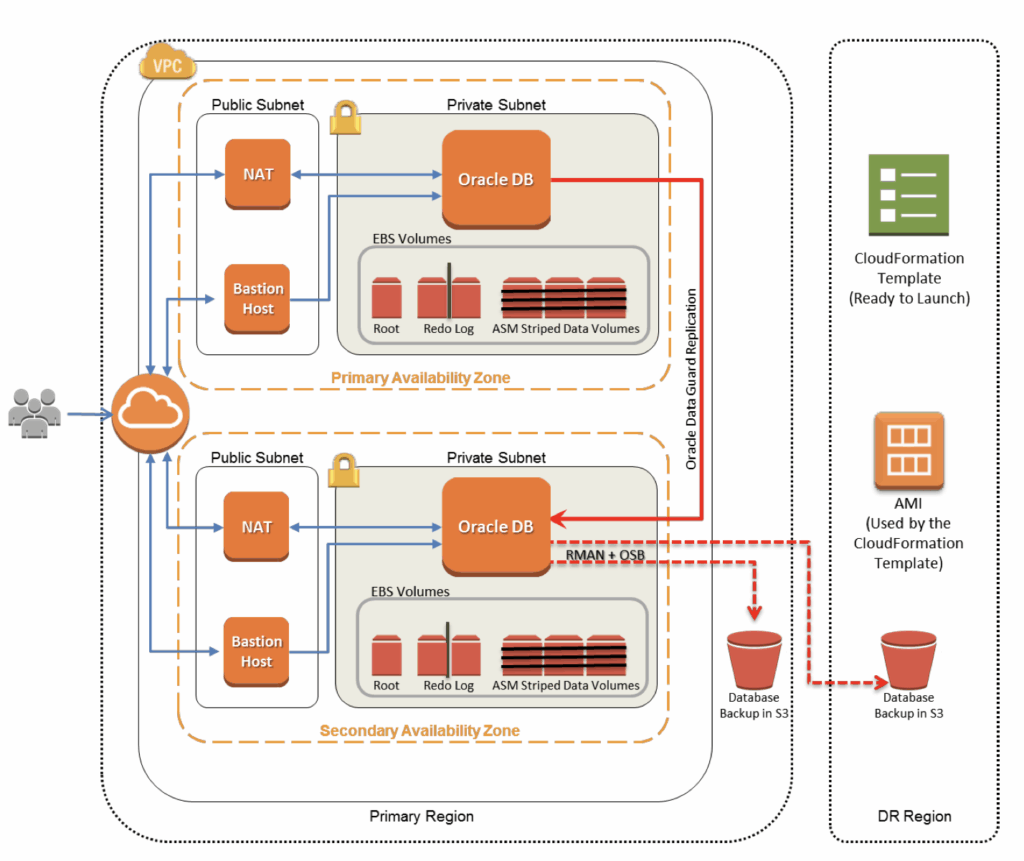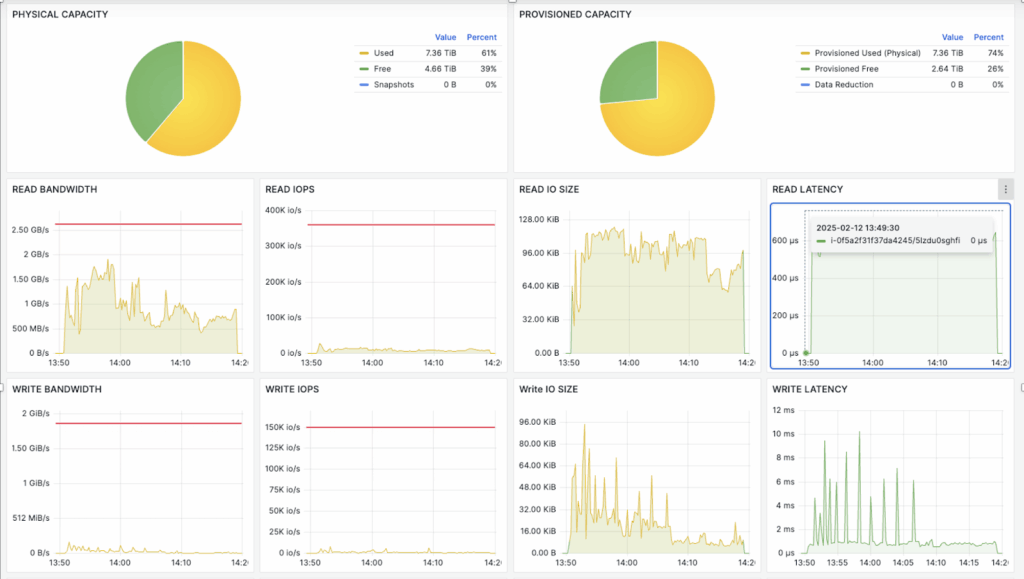SVP of Advanced Technology
Philippe Ciampossin
Migrating Oracle databases to the cloud is not a technical upgrade—it’s a business revolution. The move exposes every hidden inefficiency in your architecture, forcing organizations to confront legacy technical debt and operational silos head-on. This is why a leading technology company is accelerating its cloud transformation by modernizing its core Oracle Database and data warehousing operations on AWS. To support its most demanding workloads, the company has implemented Volumez’s advanced block storage solution, ensuring consistently high performance and predictable, resilient storage.
Vision
A leading technology company, who specializes in software solutions for the media and advertising industry, is pushing the boundaries of what’s possible in the cloud. With high-performance Oracle Databases and data warehousing workloads at the core of its operations, the company needed more than just lift-and-shift to Amazon Web Services (AWS)—it needed consistent speed, resilience, and cost control at scale. The vision: deliver cloud-native Oracle environments with uncompromising performance, built-in resiliency, and a dramatically lower total cost of ownership. By reimagining their infrastructure for the cloud, the company is also accelerating their ability to serve their clients—offering faster application performance, enhanced customer experiences, greater reliability, and the agility to innovate in step with the evolving needs of the media and advertising landscapes.
Challenge: Resilience at a premium
Each Oracle deployment was architected for maximum availability by utilizing two storage-optimized AWS EC2 i3en.12xlarge instances, distributed across separate AWS availability zones, see Figure 1. This setup followed an active/hot-standby model, with Oracle Database Enterprise Edition (EE) and Oracle Active Data Guard (ADG) providing real-time data replication across approximately 10TB of EBS storage. The customer configured each instance with four 7,500GB disks, and data volumes were efficiently managed using Oracle Automatic Storage Management (ASM). This robust architecture ensured continuous operations, minimized downtime, and safeguarded critical data.

While the setup delivered resiliency and performance, it came at a steep cost. To meet workload demands, the company had to overprovision EC2 and EBS resources—well beyond actual requirements—just to achieve consistent performance. Maintaining zone-level failover protection meant doubling Oracle EE and ADG licensing. The outcome: rising cloud bills and mounting operational complexity with each new deployment.
Strategy: Rethink the stack, not just the setup
To reduce costs without compromising performance or resilience, the company knew it couldn’t just tune its existing Oracle deployments—it needed to modernize them. That meant finding a solution that delivered enterprise-grade performance and disaster recovery, but with far less operational and financial overhead.
They partnered with Volumez, a data infrastructure as a service provider that could deliver performance at scale and a leaner operational model. Volumez introduced a new Oracle architecture – composable block storage, native AWS integration, and full Infrastructure-as-Code. With built-in mirroring and no reliance on traditional DR tooling, the company was able to streamline deployment, scale faster, and shed the complexity of legacy Oracle designs.
Strategically, partnering with Volumez was a platform-level decision to rethink how Oracle should run in the cloud.
Solution: High-performance Oracle, without the overhead
Volumez delivered the performance backbone the technology company needed, without the bulk of legacy infrastructure. Volumez’s controller-less architecture, built using NVMe-backed EC2 instances, bypasses traditional storage layers and delivered extreme performance with exceptional cost economics. With built-in cross-zone resilience and lean, efficient resource usage, the company was able to run Oracle at full throttle using Volumez, without paying for redundancy it didn’t need.
One of the first cost wins came from the freedom to right-size compute based on Oracle workload requirements. With Volumez delivering consistent, ultra-low latency performance, eliminating the need for overprovisioned compute, the company was able to swap i3en.12xlarge EC2 instances for memory-optimized r7i.12xlarge EC2 instances, see Figure 2. These instances were better aligned to Oracle’s actual CPU and memory profile, and slashed EC2 costs by ~20%, saving $12K per year per deployment.

Volumez media nodes enabled direct NVMe SSD access to Oracle database instances, via the native Linux I/O data path, allowing Oracle to bypass the performance limitations of traditional EBS storage. To ensure data resiliency, the NVMe devices were configured in a RAID 10 setup, combining striping with Volumez’s cross-zone mirroring for high availability, see Figure 2. View the dashboards in Figure 3 for the performance results, including:
- Predictable 140K+ IOPS
- 1.5 GB/s sustained throughput
- Sub-millisecond average latency

Volumez’s cross-zone mirroring delivered further cost reductions, removing the need for a hot-standby configuration and Oracle ADG licenses. The company retained its 1-hour RPO/RTO targets using a cold-standby configuration instead, enabling it to cut Oracle EE licensing and support costs by $264K in year one and $59K annually thereafter.
Finally, Volumez’s data infrastructure-as-code model transformed the deployment process. Defined entirely in YAML, Oracle environments could now be spun up rapidly, consistently, and repeatedly—cutting operational friction and accelerating the pace of delivery across dev/test and production.
Key innovations delivered
By eliminating bloated infrastructure and optimizing Oracle licensing, Volumez didn’t just fine-tune the company’s Oracle stack—it fundamentally reshaped the economics of running Oracle in the cloud. Highlights include:
- Controller-less NVMe architecture
Volumez bypassed legacy storage stacks by orchestrating direct NVMe access from EC2 to storage via native Linux paths, delivering predictable high performance of 140K+ IOPS, 1.5 GB/s throughput, and sub-millisecond average latency.
- Data resiliency and cross-zone mirroring
Built-in mirroring across zones removed the need for Oracle ADG and hot-standby infrastructure, while still meeting 1-hour RPO/RTO requirements.
- Smarter EC2 sizing
Replacing i3en.12xlarge with memory-optimized r7i.12xlarge instances slashed compute costs by ~20%, saving $12K per year per deployment.
- Oracle license optimization
Eliminated redundant Oracle EE and ADG licensing, saving $264K in year one and $59K/year thereafter—a total of $400K+ in 3-year savings per Oracle deployment.
Conclusion: Cloud efficiency, redefined
By replacing legacy assumptions with modern architecture, this technology leader didn’t just improve Oracle performance—it redefined what Oracle in the cloud can look like. With Volumez, they gained a future-proof foundation – faster, leaner, and dramatically more cost-effective.
Ready to cut costs and boost performance like never before?
Volumez makes it possible. Request a demo today!
SVP of Advanced Technology
Philippe Ciampossin
As Senior Vice President of Advanced Technology at Volumez, Philippe Ciampossin leads global engineering and product teams to deliver cutting-edge cloud solutions. Renowned for aligning customer needs with product strategy and execution, Philippe drives Volumez’s product vision and go-to-market success. Previously, he was Vice President of Engineering at NetApp, overseeing ONTAP solutions across AWS, GCP, and Azure. His experience spans AI and analytics at Cisco, M&A leadership at EMC, and advisory roles for emerging tech companies.
